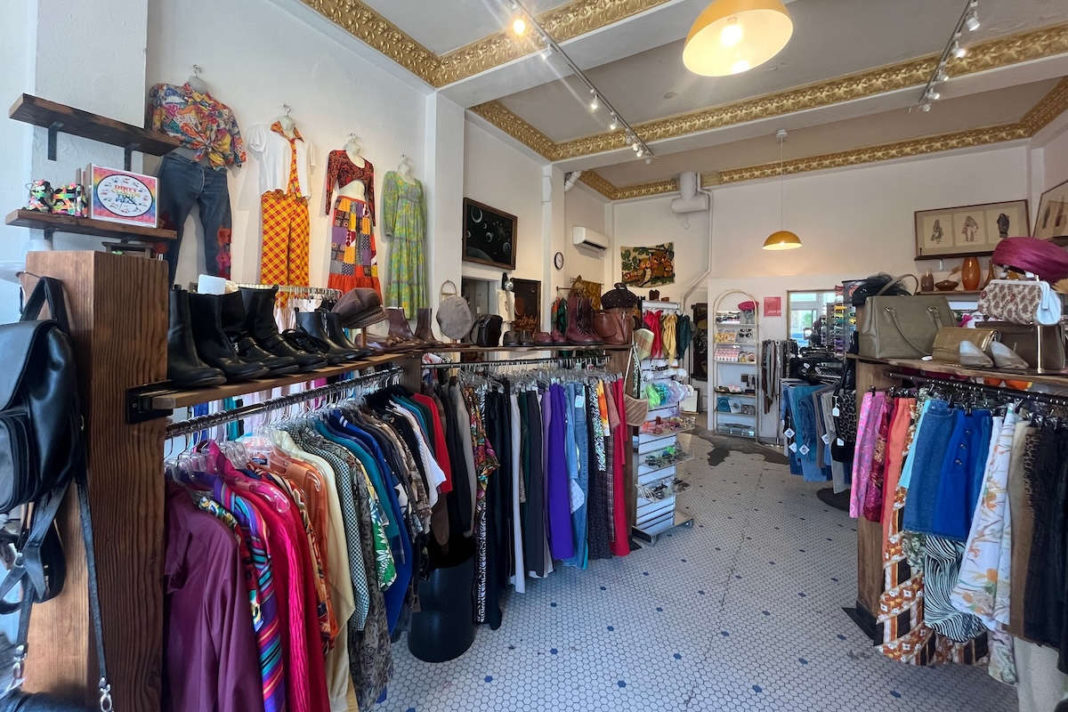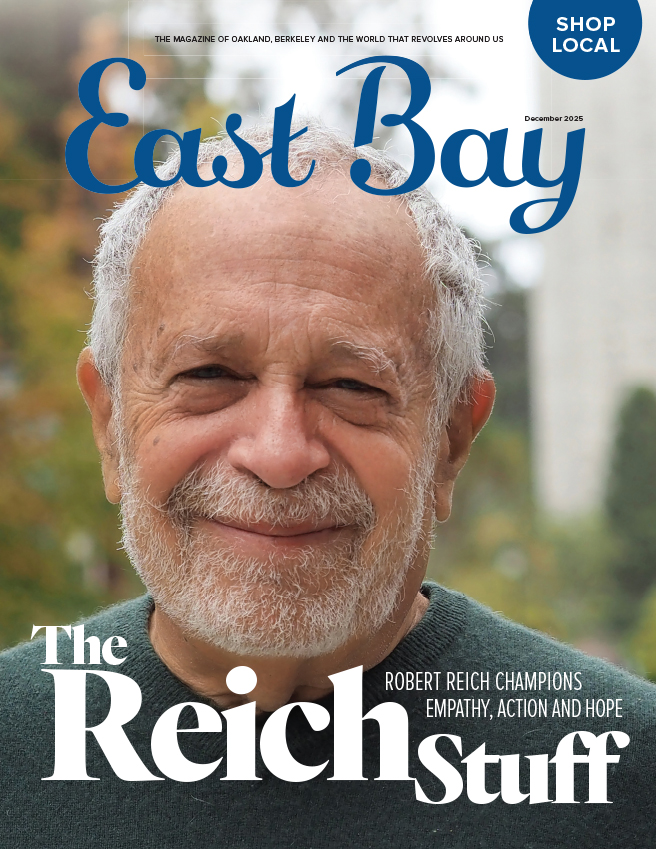Oakland’s vintage shops may be one-of-a-kind, yet many have similar beginnings. Karen Fort, owner of Mercy Vintage in Rockridge, attests: “There’s a lot of origin stories that start like mine.”
Her mom was an antiquer, she says, and Fort began “treasure hunting” seriously after volunteering at a thrift shop during high school. She became obsessed, starting to collect pieces she loved, then buying and selling them as a side job. A teacher at the time, Fort recalls the cycle took over her life until she had to make a call.
“I either needed to go for it or just quit it,” she says. She went for it, opening up a small shop in Berkeley, then Mercy Vintage’s original location 15 years ago.
The formula—the hobby to storefront pipeline—is a common refrain. At Serial Material in West Oakland, shop owner Jeanette De Mello used to go vintage shopping with her grandmother. She and her business partner, Jackki Gude, spent the past decade “slinging suitcases” and selling clothes on Etsy.
Lou Lou Rosenthal says she and Kylee Kienitz, who are co-owners of Heads or Tails Collective on Piedmont, have been “collectors slash hoarders since we were young,” and met selling their stashes in pop-ups across the bay.
Today, they all remain dedicated to the genre with the same fervor that hooked them in the first place—in a time when vintage has never been so loosely defined and in demand.
What Is Vintage?
First, a brief vocabulary lesson, to differentiate between the terms “vintage” and “secondhand.” Caveat: The definitions are debatable.
“Technically ‘vintage’ is anything 20 years or older, and ‘antique’ is anything 100 years or older,” says Fort of Mercy Vintage. OK, that’s clear. “But all the rules have been erased, and I love it.”
Ah. That leaves the current trove of trending Y2K clothes qualifying as vintage, a wildly uncomfortable idea for people who wore those trends and prefer not to acknowledge that was 20 years ago. (Editor’s note: Present company included.)
“Nowadays, vintage can mean anything up until the mid-2000s, which, to me, feels like a stretch of the term,” says Rosenthal of Heads or Tails.
At Serial Material, De Mello takes a similar stance. “I don’t consider 2021 vintage,” she says. Furthermore, “Secondhand clothing seems to be more for people doing their own selling out of their own closets. It doesn’t necessarily involve a store.”
That’s exactly the realm Iluka Enright, founder of Seconds Market, wants to occupy. The recurring pop-up market, where people can purchase space to sell racks of their own clothing, focuses on the term “secondhand” so exclusively it’s built into the name. Enright wanted to fill the gap between donation options and consignment store selling to provide a better option for “real people” to deal with clothes they no longer want. Her model is a piece of a vastly growing market.
A Trend Toward Vintage
Spurred by the pandemic, shop owners say, the broad category of thrifted clothing—that is, used clothing, whatever its label—has seen a huge surge in demand. A 2024 report from online consignment shop ThredUp expects the U.S. secondhand apparel market to reach $73 billion by 2028. While this has been mostly good for business, the swell has skewed vintage valuations in the process.
“Since vintage got really popular,” says Rosenthal, “I’ve seen things selling for amounts that feel really unattainable.”
Fort echoes this phenomenon, saying some vintage clothing has reached an “insane stratosphere of cost.” These concerns largely revolve around hyped-up, high-end designer pieces.
Conversely, not all customers understand the value of older clothing in a world where mass-manufactured fashion can be called vintage. The pre-1970s styles these shop owners grew up searching for are much harder to source. And since the quality of these goods also rivals its fashion industry successors, they can warrant a higher price that not everyone is willing to pay.
Even with this conundrum, these shop owners seem unconcerned. While they prioritize accessibility in pricing, mostly they know their customers.
“People seeking it out will pay what it’s worth,” says Gude of Serial Material.
The Vintage Shopper
Shop owners universally told me that there is no “typical” customer by demographic parameters. Many focus on making their curated styles as widely accessible as possible instead.
“All we can really hope for [is] that anyone can hop in the store and find something they like,” says Rosenthal. Heads or Tails Collective doesn’t gender their clothes. “If it fits your body and your taste, that’s great.”
Rosenthal says the shop tends to stock bright, bold patterns and psychedelic swirls, aesthetics from the 1960s and 1970s that she and her co-owner are personally attracted to. Serial Material’s shop slogan promises “a look that kills!” They’re proud to share that their biggest customer is Fantastic Negrito, the renowned Oakland singer-songwriter and three-time Grammy winner who often wears their clothing for his shows in, yes, pretty killer looks.
The two shops also place emphasis on their in-person shopping experiences. Both have opened up new storefronts they hope will attract more foot traffic. While online sales are part of their selling equation, it can be an extensive amount of work to create accurate, detailed posts that don’t always measure up.
“You can provide every measurement you’re going to take, and you still won’t know how it fits until you try it on,” says Rosenthal. “There’s nothing better than seeing someone come out of a dressing room with a giant grin on their face because they found something that fit them perfectly.”
Heads or Tails recently moved down Piedmont Avenue to the former space of Mercy Vintage—which itself relocated to a 3,000 square foot store in Rockridge. Fort shares that online sales have kept pace with in-store ones, in some years even outselling them, with sales coming in from big markets in New York, Los Angeles and Texas. Inventory moves online or in-person, she says, when everything is rare.
“There’s a kind of built in excitement,” says Fort. “If you see it, someone else is gonna swoop on it if you don’t move on it.”
For the Love of the Planet
Selling vintage clothing has always been an occupation for the passionate. For some, what started as a passion for designs or textile has evolved and expanded to recognize the importance of sustainability within the clothing industry, for which vintage clothing is uniquely suited.
“People are really aware of and people are really understanding the detriment of fast fashion on humanity,” says Fort, adding that there’s more of an appreciation for items that last. That’s led her to pursue a new idea, another term in the thrift lexicon: future-vintage.
“Future-vintage” items are made today but to the level of quality that will ensure their longevity. Fort cites Ulla Johnson, Zimmerman and DÔEN as contemporary brands she carries at Mercy that qualify. It’s also a response to customers asking her to curate unique collections and the expansiveness of what vintage means today.
Keeping items out of landfills, says Rosenthal, is part of their shop’s premise. “One of the reasons we wanted to do this in the first place is we found the styles timeless, but [also] the quality was better.”
Still, there’s nothing like a first love. Through trend cycles and planetary shifts, these shop owners will keep digging through piles and bins and racks and feeds to bring back from history what others have left behind, with a kind of dedication that’s practically sacred.
“We literally go to flea markets every Sunday,” De Mello tells me. “We call it church.”
Mercy Vintage, open Mon–Fri 11am–6pm; 5505 College Ave., Oakland. 510.325.7324. mercyvintage.com.
Serial Material, open Wed 12–7pm, Thur–Fri noon–8pm, Sat 11am–8pm, Sun 1–6pm; 1634 7th St., Oakland. 415.961.7601. instagram.com/serialmaterial.
Heads or Tails Collective, open Wed–Sun noon–6pm; 4188 Piedmont Ave., Oakland. 510.214.6240. headsortailscollective.com.











